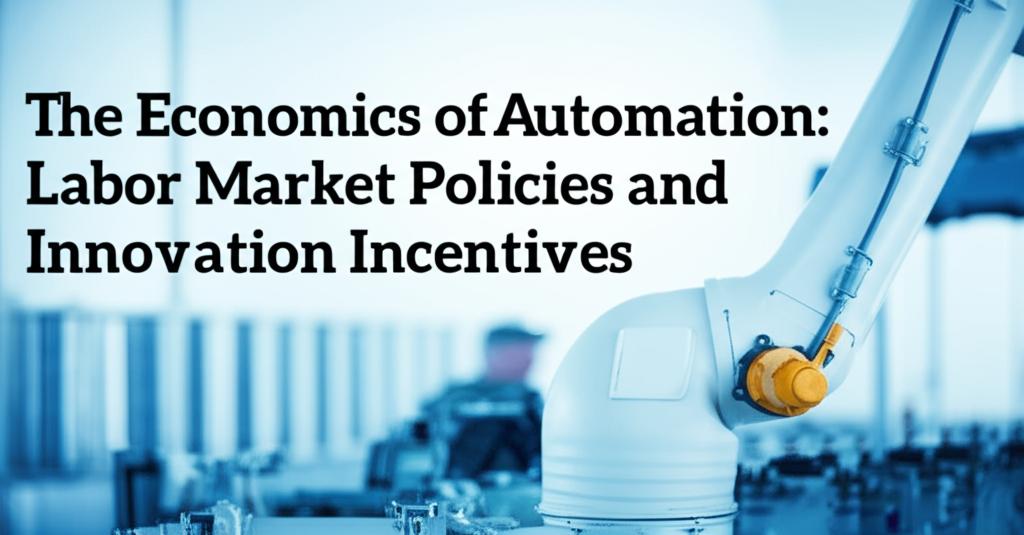Automation, encompassing advancements in robotics and artificial intelligence (AI), is fundamentally reshaping economies and labor markets worldwide. While these technologies offer significant potential for productivity gains, economic growth, and innovation, they also present complex challenges related to job displacement, wage inequality, and the changing nature of work. Understanding the interplay between automation's economic effects, appropriate labor market policies, and effective innovation incentives is crucial for navigating this transition successfully.
Labor Market Impacts: Displacement, Creation, and TransformationHistorically, technological progress has often led to job creation outweighing job destruction over the long term. Automation increases productivity, potentially lowering costs and prices, which can boost consumer demand and lead to new job growth in various sectors. Workers who can complement new technologies often see their productivity and compensation rise.
However, the current wave of automation, particularly driven by AI, differs in its potential scope. It's not just routine manual tasks that are being automated; increasingly, machines can perform complex cognitive tasks previously done by humans, potentially affecting a wider range of occupations, including white-collar professions like accounting, law, and even healthcare diagnostics. This raises concerns about:
- Job Displacement: Workers whose tasks can be substituted by machines face displacement or downward pressure on wages. Research indicates that industrial robots have already had measurable negative impacts on employment and wages in specific sectors and regions, particularly for lower and middle-skilled workers performing manual tasks.
- Wage Polarization: Automation can exacerbate income inequality. High-skilled workers whose jobs involve creativity, critical thinking, and complex problem-solving – skills complementary to AI – may see wage increases. Conversely, those in easily automatable roles may face wage stagnation or decline, widening the gap between high and low earners.
- Skills Gaps: The jobs created or transformed by automation often require different, typically higher-level skills (like digital literacy, data analysis, systems thinking, and specialized technical expertise) than the jobs displaced. This creates a skills gap, necessitating significant workforce adaptation.
To mitigate the negative consequences and ensure the benefits of automation are broadly shared, proactive and adaptive labor market policies are essential. Key areas include:
- Education, Reskilling, and Lifelong Learning: Investing in robust education and training systems is paramount. This includes strengthening STEM skills from early education, promoting vocational training in high-demand fields, and establishing accessible lifelong learning frameworks (e.g., individual learning accounts) to help workers continuously upskill and reskill throughout their careers. Support for displaced workers, including career guidance and financial aid for retraining, is critical.
- Strengthening Social Safety Nets: Enhancing support systems can cushion the impact of job displacement. This involves modernizing unemployment benefits, potentially exploring wage insurance programs (which partially replace lost income for workers taking lower-paying jobs), and expanding support like childcare and paid leave to make it easier for workers to transition or participate in training. More generous Earned Income Tax Credits (EITC) can also supplement wages for lower-income workers.
- Promoting "Good Job" Creation: Policies can incentivize employers to create jobs that offer decent wages, benefits, and opportunities for advancement. This might involve tax credits or subsidies for firms that invest in worker training or improve job quality. However, mandates like significant minimum wage hikes need careful consideration, as overly burdensome costs could accelerate automation adoption in low-wage sectors.
- Place-Based Strategies: Since automation's impact varies geographically, policies should consider regional differences in industrial structure and labor markets. Place-based initiatives can target support and investment towards areas most affected by job displacement.
The direction of technological innovation isn't predetermined; it responds to economic incentives and policy signals. Key considerations include:
- Labor Costs and Automation: Research suggests that rising labor costs, such as minimum wage increases, can incentivize firms to invest more heavily in developing and deploying labor-saving automation technologies. Conversely, rising wages for the high-skilled workers needed to implement and manage automation can make it more expensive and potentially slow down adoption.
- Tax Policy: Current tax systems often favor capital investment (including automation) over labor. Rebalancing tax incentives, perhaps by reducing payroll taxes or rethinking depreciation rules for automation equipment, could influence firms' decisions regarding automation versus hiring. Some propose taxing robots or AI, though this remains highly debated due to potential negative impacts on innovation and productivity.
- Regulation and Market Structure: Regulations and competition policy can shape the development and deployment of AI. Concerns exist that market concentration in AI development could stifle broader innovation and lead to automation focused purely on cost-cutting rather than creating new, complementary roles for humans. Policies promoting competition and diverse research pathways (including public and academic research) might encourage AI that augments human capabilities.
- Automated Incentive Systems: Businesses themselves are using automation to refine their own incentive programs, employing software to track performance, distribute rewards, and personalize incentives for employees or partners, thereby boosting engagement and efficiency.
The economics of automation involve a complex trade-off between efficiency gains and potential labor market disruption. While automation drives productivity and economic growth, it risks increasing inequality and displacing workers if not managed carefully. Effective labor market policies focused on reskilling, robust safety nets, and promoting quality jobs are crucial for helping workers adapt. Simultaneously, thoughtful consideration of innovation incentives, tax structures, and regulations can help steer technological development in ways that benefit society broadly. A collaborative approach involving governments, businesses, educational institutions, and workers themselves is needed to navigate the transition and build an inclusive future where technological progress enhances prosperity for all.

